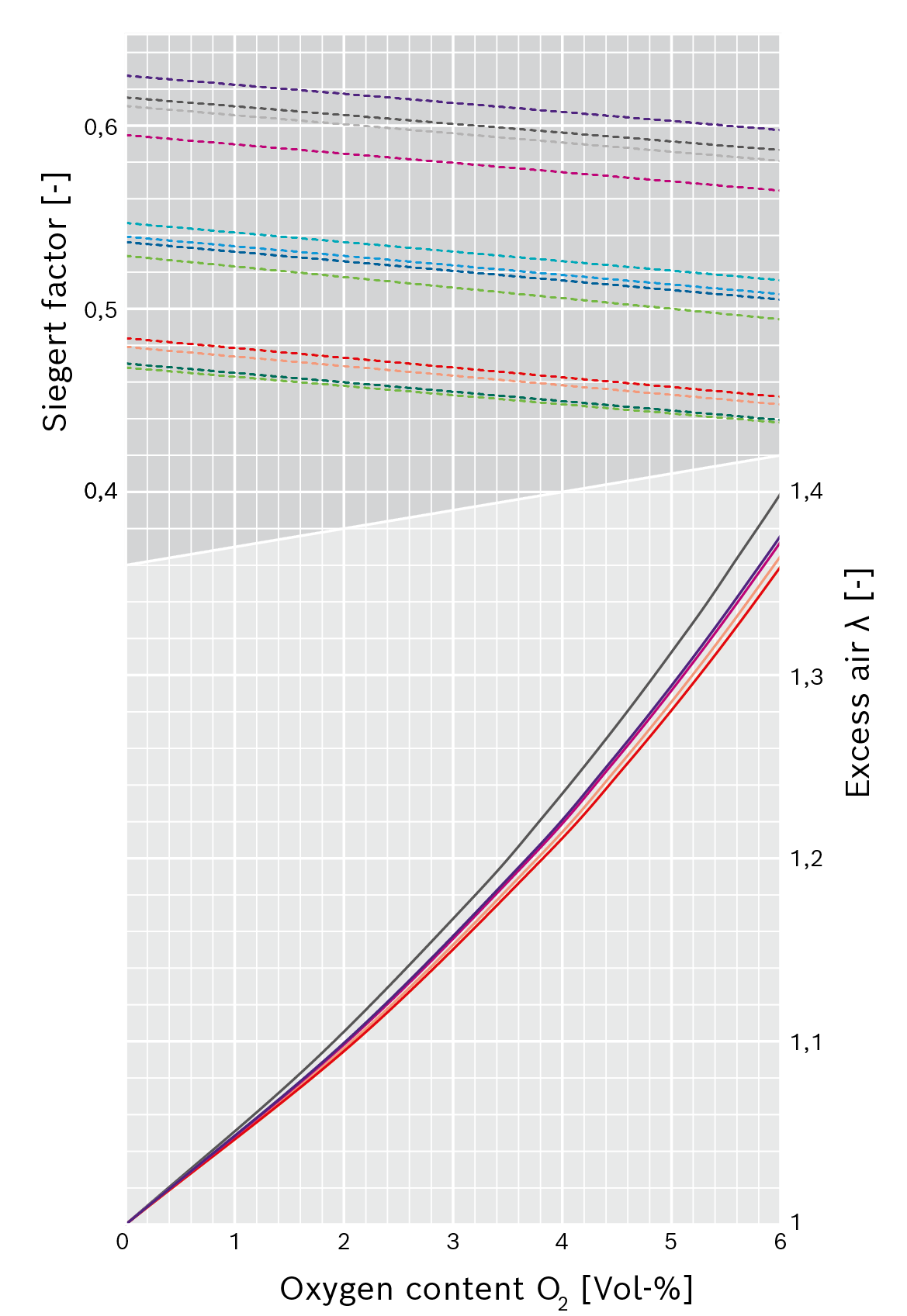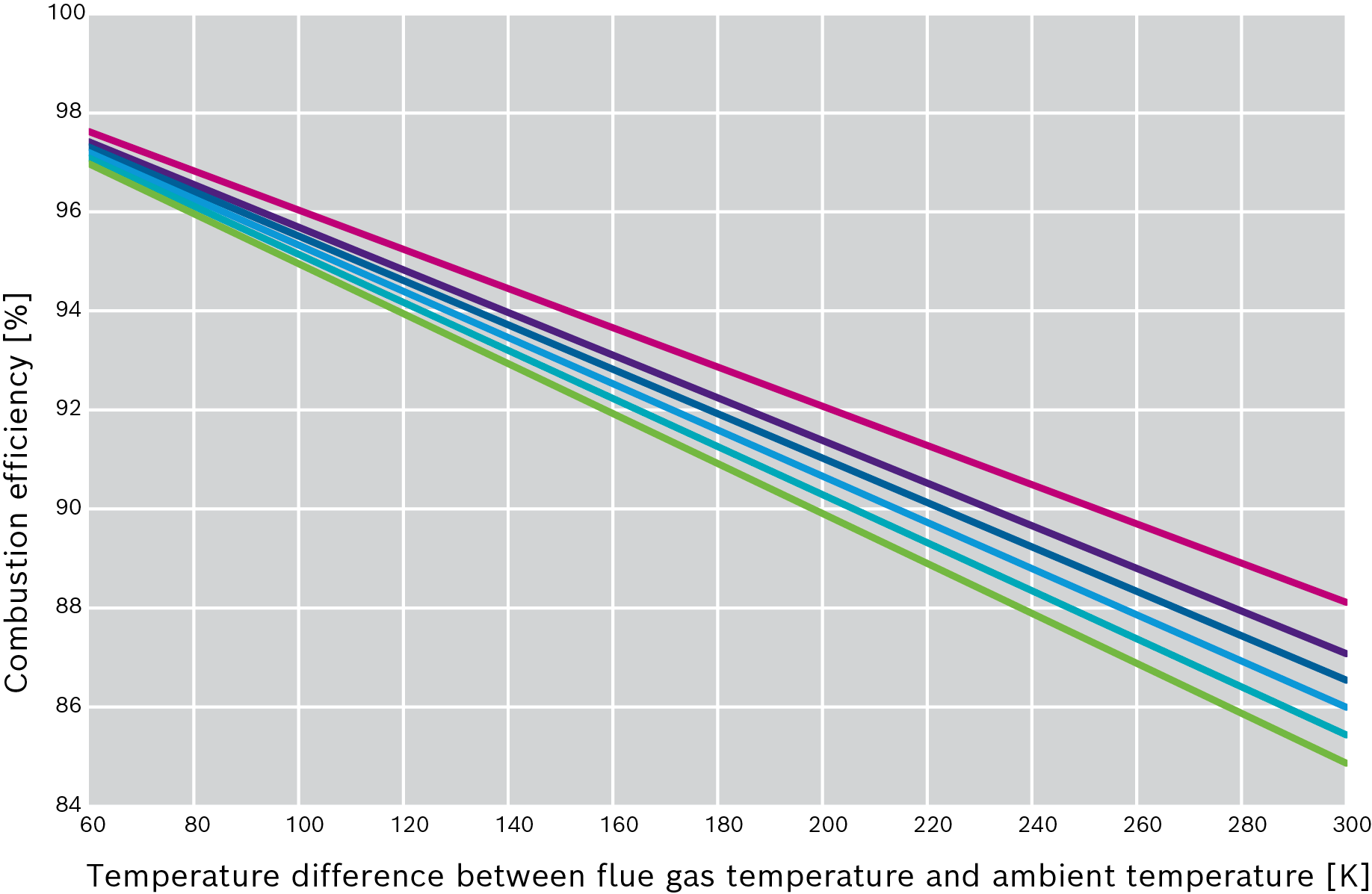Combustion efficiency
The combustion efficiency ηf describes the sensible heat yield during combustion of a fuel. It is determined by calculating the thermal losses qA in the flue gas with reference to the ambient temperature level. Unburnt components of the fuel are not taken into account for oil and gas combustion since in practice they must not occur on a relevant scale.
Info on Net calorific value, gross calorific value and condensation heat
The combustion efficiency is based on the net calorific value of a fuel and is calculated by deducting the flue gas losses from the maximum achievable 100%.

Excess air
The excess air is the ratio of actual quantity of air supplied to the required stoichiometric quantity of air.

The simplified equation for conversion of the flue gas oxygen content only applies for a flue gas/air ratio of ~ 1.

Fig. "Correlation between oxygen content in dry flue gas, excess air and Siegert factor"
|
λ |
Excess air |
|
ṁL |
Actual heat |
|
ṁL, st |
Stoichiometric heat |
|
O2 |
Oxygen [% by vol.] |
To calculate the flue gas loss, the percentage of CO2 or O2 in the flue gas and temperature differential between the flue gas temperature and ambient temperature are determined. The maximum CO2 percentages in the flue gas, which depend on the fuel used in each case, and the Siegert factor f, which depends on the measured O2 content, are also required.
If only the CO2 value in the dry flue gas is measured, the following conversion applies:
|
Siegert factor |
Siegert factor |
||
|
Fuel |
CO2,max |
f1 = f (O2 = 0 %) |
f2 = f (O2 = 5 %) |
|
Natural gas L |
11.67 % |
0.4792 |
0.4530 |
|
Natural gas H |
11.94 % |
0.4731 |
0.4469 |
|
Fuel oil EL |
15.31 % |
0.4535 |
0.4342 |
|
Fuel oil SA |
16.02 % |
0.4570 |
0.4389 |
|
Propane |
13.69 % |
0.4575 |
0.4352 |
|
Propane-Butane |
13.78 % |
0.4570 |
0.4349 |
|
Butane |
13.99 % |
0,.563 |
0.4346 |
|
Natural gas GZ35 |
11.12 % |
0.4871 |
0.4611 |
|
Natural gas GZ41.5 |
11.67 % |
0.4604 |
0.4358 |
|
Natural gas GZ50 |
11.67 % |
0.4835 |
0.4569 |
|
Medium fuel oil HL Schwechat |
15.72 % |
0.4534 |
0.4348 |
|
Medium fuel oil CLU 3 |
16.11 % |
0.4458 |
0.4285 |
Siegert factors of various fuels

|
Calculation of Siegert factor for any given oxygen content in dry flue gas O2:
|

Correlation between oxygen content in dry flue gas, excess air and Siegert factor
|
|
21 % (21 % – O2) |
|
|
Natural gas L |
|
|
Natural gas H |
|
|
Fuel oil EL |
|
|
Fuel oil SA |
|
|
Natural gas L |
|
|
Natural gas H |
|
|
Fuel oil EL |
|
|
Fuel oil SA |
|
|
Propane |
|
|
Propane-Butane |
|
|
Butane |
|
|
Natural gas GZ35 |
|
|
Natural gas GZ41.5 |
|
|
Natural gas GZ50 |
|
|
Medium fuel oil HL Schwechat |
|
|
Medium fuel oil CLU 3 |
Notes:
- For excess air: natural gas GZ 41.5/50, propane, butane, propane-butane coincides virtually exactly with natural gas L and is therefore not shown.
- Medium fuel oil CLU 3 and medium fuel oil HL Schwechat are between the curves of fuel oil EL and SA, and are therefore not shown.
The combustion efficiency increases starting from the full load until roughly 35% partial load with a boiler system. The excess air and therefore the CO2 content measured in the dry flue gas increases only slightly while the flue gas temperature falls due to more efficient utilisation of the heating surface in the boiler. At a partial load of <35% the greater amount of excess air which is necessary prevails and the combustion efficiency falls again.
The combustion efficiency is determined during emission measurement by the chimney sweep or customer service, for example. Heat losses due to radiation and conduction on the surface of the boiler are not taken into consideration in this case.
The relationship between combustion efficiency and flue gas temperature with varying excess air is shown in the following diagram for the fuel natural gas H. The higher the flue gas temperature the lower the efficiency.
The diagram also clearly shows that the increase in efficiency is particularly high with less excess air, i.e. low λ values, especially with high flue gas temperatures.

Efficiency curve with reference to excess air λ without condensation, using natural gas H as example
|
|
λ = 1 (O2 = 0 %) |
|
|
λ = 1.1 (O2 = 2.14 %) |
|
|
λ = 1.15 (O2 = 3.09 %) |
|
|
λ = 1.2 (O2 = 3.96 %) |
|
|
λ = 1.25 (O2 = 4.77 %) |
|
|
λ = 1.3 (O2 = 5.52 %) |


























